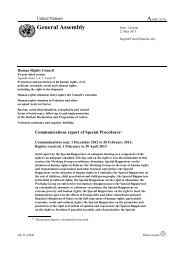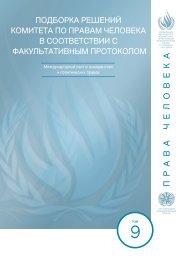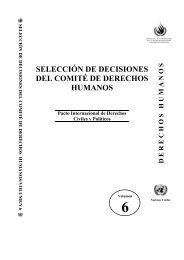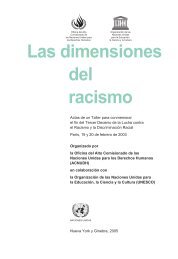good governance practices for the protection of human rights
good governance practices for the protection of human rights
good governance practices for the protection of human rights
You also want an ePaper? Increase the reach of your titles
YUMPU automatically turns print PDFs into web optimized ePapers that Google loves.
elies on a conducive and enabling environment. This includes appropriate legal<br />
frameworks and institutions as well as political, managerial and administrative<br />
processes responsible <strong>for</strong> responding to <strong>the</strong> <strong>rights</strong> and needs <strong>of</strong> <strong>the</strong> population.<br />
This publication defines <strong>good</strong> <strong>governance</strong> as <strong>the</strong> exercise <strong>of</strong> authority through<br />
political and institutional processes that are transparent and accountable, and<br />
encourage public participation. When it talks about <strong>human</strong> <strong>rights</strong>, it refers to <strong>the</strong><br />
standards set out in <strong>the</strong> Universal Declaration <strong>of</strong> Human Rights and elaborated<br />
in a number <strong>of</strong> international conventions that define <strong>the</strong> minimum standards to<br />
ensure <strong>human</strong> dignity (see box).<br />
It explores <strong>the</strong> links between <strong>good</strong> <strong>governance</strong> and <strong>human</strong> <strong>rights</strong> in four areas,<br />
namely democratic institutions, <strong>the</strong> delivery <strong>of</strong> State services, <strong>the</strong> rule <strong>of</strong> law<br />
and anti-corruption measures. It shows how a variety <strong>of</strong> social and institutional<br />
actors, ranging from women’s and minority groups to <strong>the</strong> media, civil society and<br />
State agencies, have carried out re<strong>for</strong>ms in <strong>the</strong>se four areas.<br />
When led by <strong>human</strong> <strong>rights</strong> values, <strong>good</strong> <strong>governance</strong> re<strong>for</strong>ms <strong>of</strong> democratic institutions<br />
create avenues <strong>for</strong> <strong>the</strong> public to participate in policymaking ei<strong>the</strong>r through<br />
<strong>for</strong>mal institutions or in<strong>for</strong>mal consultations. They also establish mechanisms <strong>for</strong><br />
<strong>the</strong> inclusion <strong>of</strong> multiple social groups in decision-making processes, especially<br />
locally. Finally, <strong>the</strong>y may encourage civil society and local communities to <strong>for</strong>mulate<br />
and express <strong>the</strong>ir positions on issues <strong>of</strong> importance to <strong>the</strong>m.<br />
In <strong>the</strong> realm <strong>of</strong> delivering State services to <strong>the</strong> public, <strong>good</strong> <strong>governance</strong> re<strong>for</strong>ms<br />
advance <strong>human</strong> <strong>rights</strong> when <strong>the</strong>y improve <strong>the</strong> State’s capacity to fulfil its responsibility<br />
to provide public <strong>good</strong>s which are essential <strong>for</strong> <strong>the</strong> <strong>protection</strong> <strong>of</strong> a number<br />
<strong>of</strong> <strong>human</strong> <strong>rights</strong>, such as <strong>the</strong> right to education, health and food. Re<strong>for</strong>m initiatives<br />
may include mechanisms <strong>of</strong> accountability and transparency, culturally<br />
sensitive policy tools to ensure that services are accessible and acceptable to all,<br />
and paths <strong>for</strong> public participation in decision-making.<br />
When it comes to <strong>the</strong> rule <strong>of</strong> law, <strong>human</strong> <strong>rights</strong>-sensitive <strong>good</strong> <strong>governance</strong> initiatives<br />
re<strong>for</strong>m legislation and assist institutions ranging from penal systems to<br />
courts and parliaments to better implement that legislation. Good <strong>governance</strong><br />
initiatives may include advocacy <strong>for</strong> legal re<strong>for</strong>m, public awareness-raising on<br />
<strong>the</strong> national and international legal framework, and capacity-building or re<strong>for</strong>m<br />
<strong>of</strong> institutions.<br />
Finally, anti-corruption measures are also part <strong>of</strong> <strong>the</strong> <strong>good</strong> <strong>governance</strong> framework.<br />
Although <strong>the</strong> links between corruption, anti-corruption measures and <strong>human</strong><br />
<strong>rights</strong> are not yet greatly explored, <strong>the</strong> anti-corruption movement is looking<br />
to <strong>human</strong> <strong>rights</strong> to bolster its ef<strong>for</strong>ts. In fighting corruption, <strong>good</strong> <strong>governance</strong><br />
ef<strong>for</strong>ts rely on principles such as accountability, transparency and participation<br />
to shape anti-corruption measures. Initiatives may include establishing institutions<br />
such as anti-corruption commissions, creating mechanisms <strong>of</strong> in<strong>for</strong>mationsharing,<br />
and monitoring Governments’ use <strong>of</strong> public funds and implementation<br />
<strong>of</strong> policies.<br />
2
















